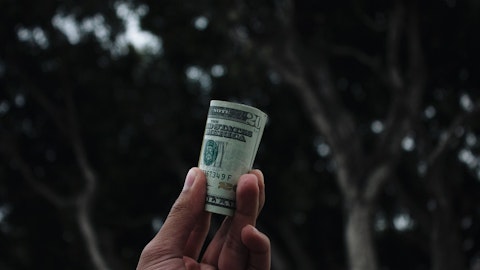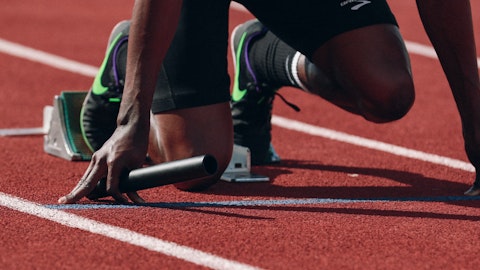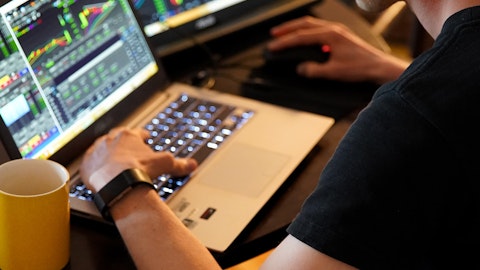Greg Melich: Got it. And then I want to follow up on this — thanks for the answer on shrink that was good and pretty holistic. Freight benefits or supply chain was a benefit that helped grow gross margin or hold stabilize it. Could you quantify that? And maybe sort of give us an idea as to how you’re thinking about that into the back half?
Carl Ford: Yes, Greg, this is Carl. So freight was a tailwind of 88 basis points during the quarter, quarter-over-quarter improvement. So up 30 basis points in gross margin, the puts and takes on that were freight was a positive, 88%. Merch was a negative 21%, shrink was a negative 37%. And we continue within the guidance to see that as a tailwind throughout fall.
Operator: Our next question comes from the line of Christopher Horvers with JPMorgan.
Christopher Horvers: Can you talk about what you’re seeing in some of the key COVID winning categories, whether it’s hunt or exercise equipment, bike and so forth? Are you seeing the bottom form in the business such that we can start to look forward to improvement in comp and then ultimately positive as you think about the out year? Or are those like basically relative to 2019, are things stabilizing and we can start to think about the business more seasonally?
Steve Lawrence: Yes. On a Y-o-Y basis, when you look at just the comparison of the bigger business, big-ticket businesses, some of the search categories you talked about, there’s a challenge, right? I mean our fitness business continues to be — fitness equipment, in particular, continues to be pretty challenged. The hunt business we’ve talked about between firm and will continue to be challenged. As we get through this year, the comps get a little less daunting the further we get through the year. So we’re counting on some of that improvement as we move through the year. But going back to the latter part of your question, when you look at these businesses versus 2019, they’re still all really, really healthy. When you look at like the hunt business.
It’s still up in the mid-40s versus ’19. And if you take a category beneath the surface are like Amol, it’s still up in like 96% versus where it was in ’19. So it’s certainly falling back a little bit from the activity we’ve seen in the last couple of years, but still maintaining a really healthy spread versus pre-pandemic. And once we kind of see this business start to stabilize, and I think it is going to stabilize at a higher level than where it was in ’19, I think that’s when we’ll start being able to move more towards growth from a total company perspective.
Christopher Horvers: So I guess just focusing on that. So in these categories broadly in the business, do you feel more confident today than a quarter ago that we are getting to that point of okay, we’re seeing a bottom form and you have better visibility as you look forward?
Steve Lawrence: They’re becoming more predictable for us. We certainly can — are getting a lot closer to pen in terms of forecasting those businesses. They’re still running negative though. I mean I don’t want to not mislead or mislead you on that. They’re running negative. But as we get through the year, these headwinds start to diminish a little bit. And so that’s what really we’re counting on as part of our guidance.
Michael Mullican: Chris, one other thing, I think if we’re looking out long term, and again, we’re focused on the long term. We’re more differentiated in this space than we were a few years ago. I think there’s fewer competitors and some of the largest competitors have really backed away from this space. So short term, definitely, as Steve said, we’re still running down in some of those categories. It is stabilizing. I think long term, we’ve got a great opportunity to pick up meaningful share and new customers as we really support and lean into this category.
Steve Lawrence: Yes, a lot of the categories that you’re talking about have major crash out across the Company. And ultimately, even though we’re fighting through some short-term chop on this, we believe the diversified assortment, the complementary nature of the businesses, and how they cross shop is the right place for us to be. We’re a sports and outdoor retailer. And candidly, as more people pull back from the outdoor space, we become maybe the only player in this space with a large footprint.
Christopher Horvers: Got it. And then my follow-up question is any help here on the back half in terms of cadence from a top line and gross margin perspective as we think about the models.
Michael Mullican: Yes. No, I think our — from a guidance perspective, we’re comfortable with the annual guidance of down 7.5 to down 4.5. The flexibility or the variability as you think about that is on consumer health. We’re going to continue to lean into value. We’re going to continue to lean into newness. It’s completely related to consumer health. And on the margin guide from 34.4% down to 34.0%, we feel comfortable with that. We’ve delivered that consistently over the past two years. It’s up 500 basis points since pre-COVID and all of those business disciplines that Steve kind of walked through of what we — this leadership team started doing in 2019 and really coming back to merchandise planning and allocation, the systems enhancements, planning and buy execution, open to buy discipline, having that markdown life cycle management, we’re doing those consistently.
That’s what we’re doing day in and day out is managing the business. And so we feel comfortable with the margin guide, and we’ve delivered it for the past two years.
Operator: Our next question comes from the line of Kate McShane with Goldman Sachs. Please proceed with your question.
Emily Ghosh: This is Emily Ghosh on for Kate. We wondered how you were thinking about the overall health of the marketplace currently and into the second half of the year. It sounds like there are some areas where there’s heavier inventory and we wondered how that might impact Academy.
Steve Lawrence: Yes. I mean, certainly, we’ve talked about we’re very comfortable with where our inventory position is. We also know that competition sometimes has some issues out there and those problems can become our problems as they liquidate product. That being said, some of the headwinds you’re talking about, there’s definitely increased promotions out there, the heavy inventories you mentioned and customers are under pressure, right? There’s the credit card that’s higher than it’s been. Inflation is real. But when you think about some of the other tailwinds we have, we’ve got this everyday value positioning that is kind of core and fundamental to who we are. And I think customers will continue to gravitate towards value.




